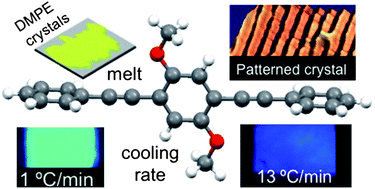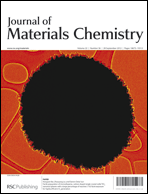Tunable solid state fluorescence behavior of a methoxy substituted oligo(phenyleneethynylene): influence of cooling rate and surface crystallization†
Abstract
Organic fluorescent materials that enable a control of the emission color based on external influence are highly sought after in optoelectronic applications. A simple molecule, a di-methoxy substituted oligo(phenyleneethynylene), whose emission can be precisely tuned by controlling the cooling rate from the melt (1–13 °C min−1 and higher) or by changing the crystallization process on substrate surfaces, is presented. Interestingly, the emission intensity at 397 nm of the melt cooled films was found to be linearly dependent on the diffraction intensity of the (200) preferred orientation of the crystallites. The surrounding medium too seems to influence the emission behavior depending on the thermal diffusivity. Furthermore, the emission is also found to be sensitive to the substrate topography and roughness as a rough surface becomes unconducive to aggregation.


 Please wait while we load your content...
Please wait while we load your content...